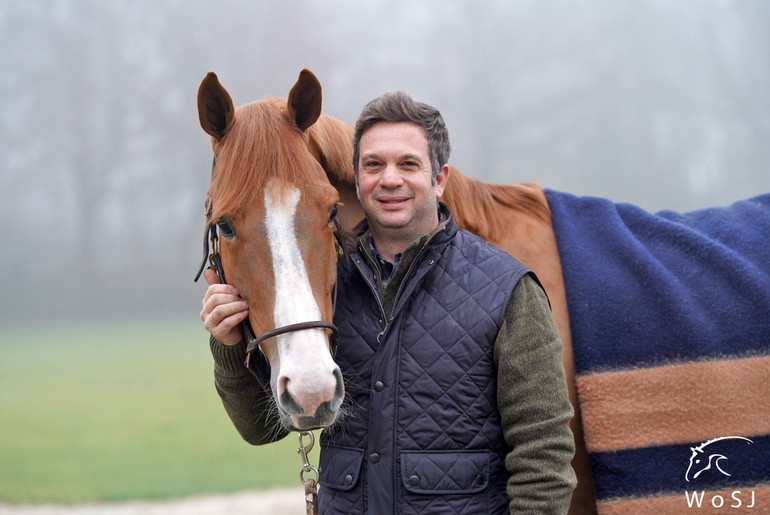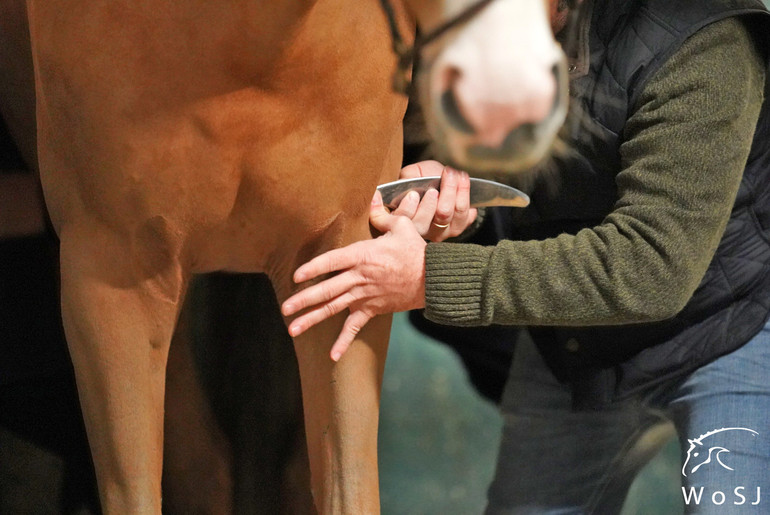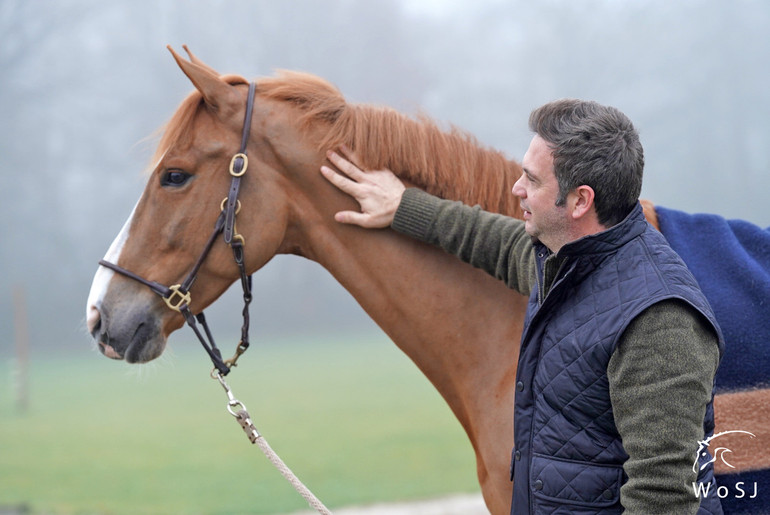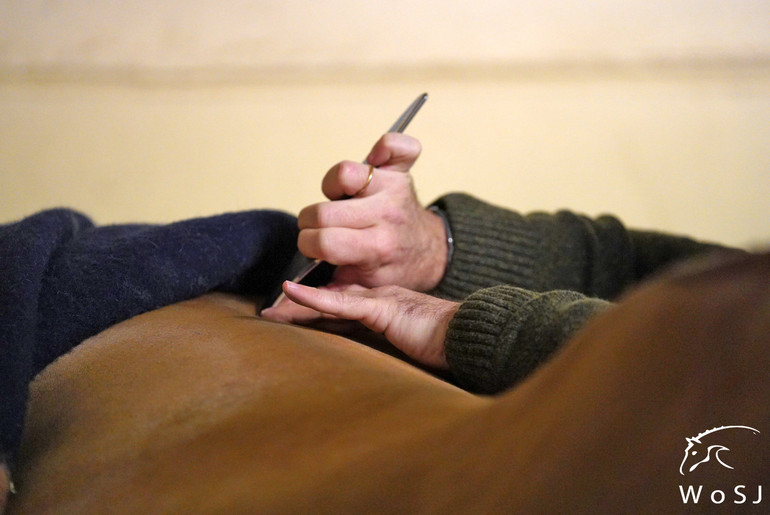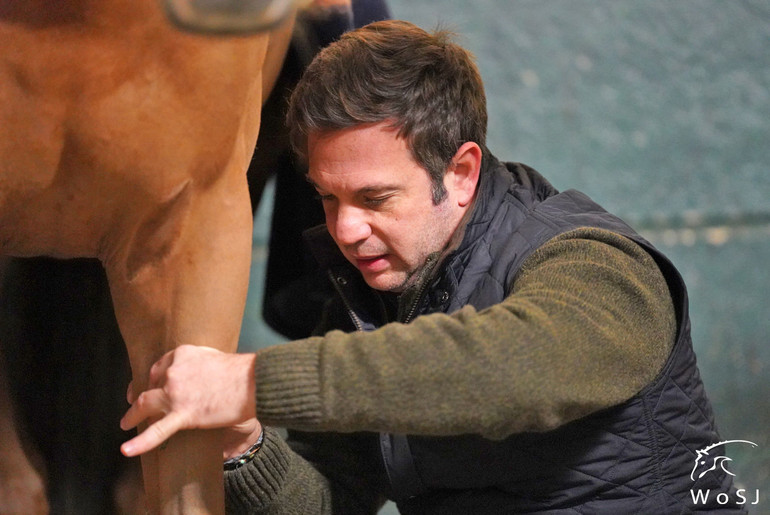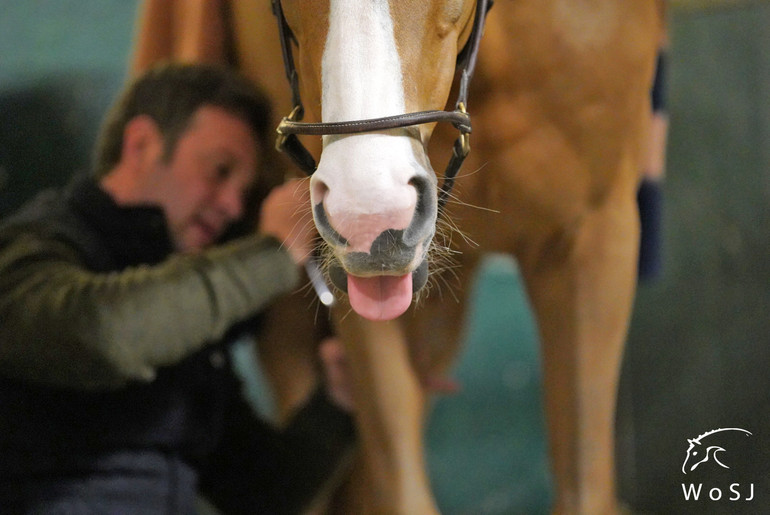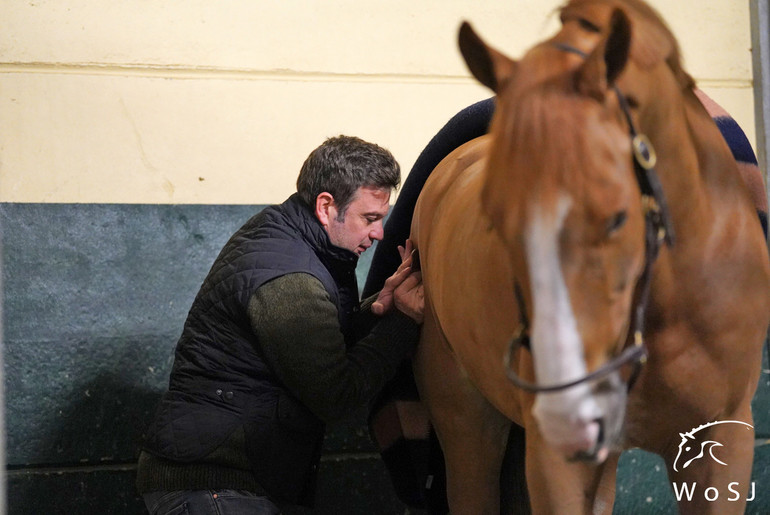Text © World of Showjumping
WoSJ had a talk with Alexander Georgiou, who after years of competing on the international showjumping circuit wanted to give something back to the horses and decided to shift his focus towards equine physiotherapy and osteopathy. “I think that having been a rider myself is an advantage for me now; I can really relate to the horses and see what is important,” Georgiou tells.
Giving back
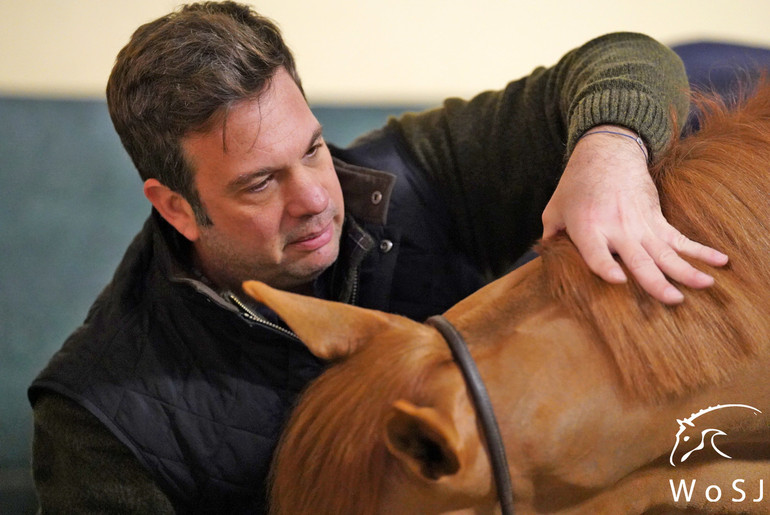
"The best thing about my work is that I don’t see it as work: I am so lucky to be able to be around horses and help them, it is very rewarding," Georgiou says. Photo © Nanna Nieminen for "When my jumping career ended, I wanted to give something back to the horses – they had done so much for me," Georgiou tells. Photo © Nanna Nieminen for World of Showjumping.
Born in Greece, Georgiou has been riding since he was a little child. “When I turned sixteen, I moved to the UK to finish school and continued riding there,” Georgiou tells. “Later, I made the national team for Greece, and got to do the whole World Cup-circuit. During my Business Information Management studies at the University of Westminster London, I continued training and riding. In the UK, I was training with Tim Stockdale and then towards the end of my jumping career with Henk Nooren in the Netherlans. I made the long-list for the Greek team for the 2004 Olympics while I was training with Henk. Unfortunately, my horse Halida got injured prior to the Games.”
“During my time at Henk’s we had a physio on our horses, which was my first encounter with that type of equine therapy,” Georgiou continues. “I got really interested, because it helped my horses so much. When my jumping career ended, I wanted to give something back to the horses – they had done so much for me. I moved back to England and studied equine physiotherapy at Writtle University College in Essex, finishing my studies in 2009. After my studies I worked with a few local vets in England.”
“As with riding, you need to love the horses and the sport, have a basic knowledge of the horses’ anatomy, but most importantly, have feeling,” he tells about his work. “I believe in the will of someone wanting to learn, but without feeling, you won’t be successful – I believe that applies to everything in life. The best thing about my work is that I don’t see it as work: I am so lucky to be able to be around horses and help them, it is very rewarding.”
“Many times, people ask me why I don’t look into helping riders as well,” Georgiou continues. “The reason is that even though I do want to broaden my knowledge, my time is limited – and I’d rather spend it on horses than humans. It is a must for me to improve my work and follow the research; new things come out constantly and you have to keep an open mind.”
A monthly check-up
At the moment, Georgiou treats horses from riders such as Taizo Sugitani, Ioli and Hannah Mytilineou, James Wingrave, Victor and Alexander Kumps as well as Alise Oken. “For my clients, I keep an eye on the horses on a monthly basis, we don’t wait until there is an issue or something is really wrong,” Georgiou tells. “If a horse is lame or injured, a vet is the first one who should look at the horse, then I am the second person to help with the rehab. With a monthly check-up, we stay on top of everything. A little stiffness or a blocked point that is not tended to straight away can cause a bigger issue later on. Seeing the horses regularly keeps them in a good range of motion and the blood circulating through the body. The better I know the horse, the easier my work is: It will be easier to spot what is wrong, and it is easier to treat issues in their early stages.”
“Seeing the horse move is always recommended; on a straight line, a bit on the lunge. Then I work through the whole body, checking all the muscles and ligaments, taking it part by part,” he continues. “With a new horse, I need to get the full history. Sometimes, owners leave information out, which is not helpful, because without a clear picture of the horse I cannot help 100%.”
“A horse of any age can benefit from physiotherapy. There is no harm doing the horses when they are young: When they are growing, their bodies change and they obviously get sore,” Georgiou says.
Proven methods
The most common issues that Georgiou sees in his work are back and tendon problems. “Each horse is different, but I often see back issues, blocks in shoulders as well as tendon strains. However, when there are small strains, we can still fix them and prevent serious issues,” he says.
Georgiou always works with his hands first, additionally he uses treatments such as shockwave, ultrasound and laser. “I always work with my hands first, and I like to stay with the more traditional equipment which has been used for years and years – its effect has been proven,” he says. “I use a low frequency ultrasound which can be hot or cold. If there is a sore or a torn muscle, I can use the ultrasound, whereas with the laser I would go more into acupuncture points. Ultrasound is also very interesting for the flexibility of the tendons. Keeping the tendons nice and flexible obviously helps in preventing injuries.”
Working on the facia is another technique Georgiou uses. “Facia is what is under the first layer of skin, it surrounds the muscles and all the bones, it is a huge piece – you can think of it as a sheet that starts from the top and goes around the whole body,” he explains. “Sometimes, when a horse gets injured, tied up or pulls a muscle, the facia sort of creases up and that obviously affects many other parts of the body. Loosening it up takes time; you have to go through the base layer of the skin, so you need to add weight to reach the facia.”
In his work, Georgiou also uses Kinesio tape. “I was very lucky, being one of the first people to learn about equine taping. I was in the first group to use tape on horses and got trained by the renowned Japanese doctor Kenzo Kase. Taping for humans has been around for years. The theory of the tape is that you can use it anywhere on a horse. It can help the flexibility of the muscles, or you can use tape to keep certain pressure points open – which is sometimes very useful. I find that the tape works well on big muscle groups; the back, the neck, the glutes – you can also use it on tendons. However, taping is not a stand-alone therapy; it is a helping hand, and a useful tool. There is no medicine on the tape, it simply pulls the skin up and basically lifting the skin lifts the facia, which gets the blood circulating going in those areas. The interesting thing is that human physios keep asking if taping works on horses’ hair, because on people, even on the arms, you have to shave everything off. That is not the case at all with horses: They have done a few trials, and once the horses were shaved, they were overstimulated. Horses have nerve endings on each hair, so they are much more sensitive in that way.”
No over-night miracles
“There are still a lot of people who don’t believe in alternative medicine like physiotherapy or osteopathy,” Georgiou says. “The only way is to try a few times and see the effect it has on the horse yourself: It betters the range of motion and accelerates blood circulation through the body. All this prevents injuries and makes the horse feel and move better. Another thing that many people believe is that one treatment will fix it all. It does not work like that and with one treatment, no one can make miracles. It takes time; after a few sessions, you have a more permanent and better result.”
“The best way to prevent issues is to keep a close eye on your horses, because you can easily prevent things from escalating,” he continues. “Little things like a bit of inflammation, issues through the spine, etc., that are not really causing big issues at the time because they are still minor, should be dealt with so that they don’t escalate. By regularly checking your horse, you can prevent a lot and the horse stays healthy longer. I think every rider should know their horse so well that they are able to feel and see even minor changes. You have to treat your horse as a partner and not as a machine. It is a living soul and our sport is a team effort; proper work and care are very important.”
“There are a lot of stretching exercises you can do, and I am also a big fan of using arnica, it can always help and never harm,” Georgiou says when asked what anyone can do at home to help their equine partners. “The only thing you should never do, is to use force. Some things take time, and by forcing anything you can do damage.”
All about teamwork
“I like to work closely with the riders as well as their whole team and have a good communication with everyone involved,” he says. “And I like working with people who are willing to learn. One of the most important aspects that I would like to emphasize, is that in order to get the best results, everyone involved must work as a team. You can only achieve top results once when everyone works together. Things do not happen overnight; it takes time, coordination, consistency and hard work.”
“I do see more and more riders seeking help in the field of alternative medicine,” Georgiou says. “The riding is also changing: Today, most riders work their horses in a different way than in the past, bringing the horses to a correct shape without forcing them. Horse welfare is obviously extremely important and that is why I do what I do; to help the horses, to keep them happy. Riders have to always have this as number one priority and everything else comes after. Horses are not machines, they are partners and we have to look out for them and keep their best interest in mind.”
No reproduction without written permission, copyright © World of Showjumping.com



